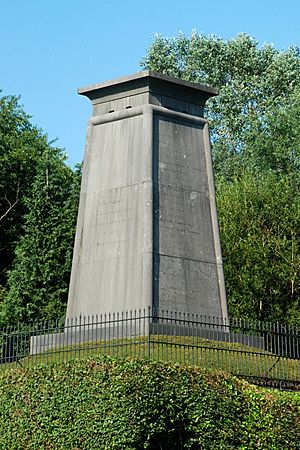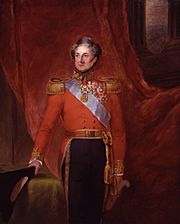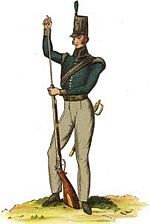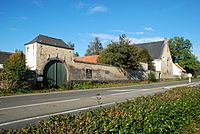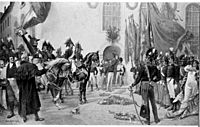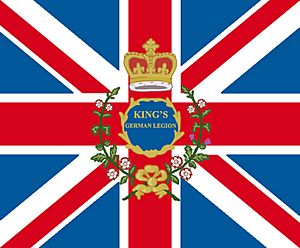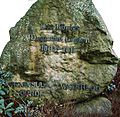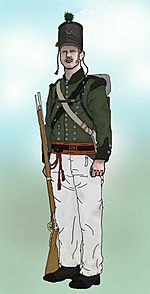King's German Legion facts for kids
Quick facts for kids King's German Legion |
|
|---|---|

(from left to right) A 5th Line Battalion ranker, a 2nd Light Battalion sharpshooter, and a 1st KGL Hussar
|
|
| Active | 1803–1816 |
| Country | Electorate of Hanover; since 1814 Kingdom of Hanover |
| Branch | British Army |
| Type | Artillery Cavalry Line infantry Light infantry |
| Size | approximately 14,000 |
| Garrison/HQ | Infantry at Bexhill-on-Sea Cavalry at Weymouth, Dorset |
| Battle honours |
|
| Commanders | |
| Notable commanders |
|
The King's German Legion (KGL) was a special group of soldiers from Germany. They fought as part of the British Army between 1803 and 1816. These brave soldiers were mostly Germans who had left their home country.
What made the KGL so special? They were the only German force that fought against the French Empire during the Napoleonic Wars without stopping. Even though they were part of the British Army and never fought completely on their own, the KGL played a very important role in many battles. Some of their most famous actions were during the Walcheren Campaign, the Peninsular War, and the Hundred Days in 1815.
The King's German Legion was officially ended in 1816. Many of its units then joined the army of the Kingdom of Hanover. Later, these units became part of the Imperial German Army after Germany became a united country in 1871.
Sometimes, people get the King's German Legion mixed up with the British German Legion. The British German Legion was formed much later for the Crimean War.
Contents
How the KGL Started
In 1803, the French army, led by Napoleon, took control of Hanover in Germany. This meant that the Electorate of Hanover, a German state, was dissolved. Its army was disbanded, and many soldiers lost their jobs.
However, the ruler of Hanover, King George III, was also the King of the United Kingdom. So, many Hanoverian officers and soldiers escaped to Britain. King George III wanted to keep fighting Napoleon.
In the same year, two important officers, Major Colin Halkett and Colonel Johann Friedrich von der Decken, were given permission to create a new group of soldiers. This group was first called "The King's German Regiment."
By December 19, 1803, these new groups were combined. They became the King's German Legion, a mixed army unit with cavalry (soldiers on horseback), infantry (soldiers on foot), and artillery (soldiers who used cannons).
The KGL grew quite large. Over time, about 14,000 soldiers and officers served at any one moment. But over its 13 years, almost 28,000 different men were part of the Legion. At first, many officers had temporary ranks. But in 1812, they were given permanent ranks in the British Army. This was because they had shown so much bravery in fighting the enemy. The KGL fought actively from 1805 until it was disbanded in 1816.
How the KGL Was Organized
The King's German Legion was made up of different types of military units, just like a modern army.
Cavalry Units
These were soldiers who fought on horseback.
- 1st Regiment of Dragoons (They wore red jackets until 1812, then changed to blue jackets and became Light Dragoons)
- 2nd Regiment of Dragoons (Also changed from red to blue jackets and became Light Dragoons)
- 1st Regiment of Hussars
- 2nd Regiment of Hussars
- 3rd Regiment of Hussars
Infantry Units
These were soldiers who fought on foot.
- 1st Light Infantry Battalion
- 2nd Light Infantry Battalion
- 1st Line Battalion
- 2nd Line Battalion
- 3rd Line Battalion
- 4th Line Battalion
- 5th Line Battalion
- 6th Line Battalion
- 7th Line Battalion
- 8th Line Battalion
Artillery and Engineers
- King's German Artillery: These units used cannons and other heavy weapons. They had two horse batteries (cannons pulled by horses) and four foot batteries.
- King's German Engineers: These soldiers helped build and destroy things on the battlefield.
Important Battles and Campaigns
The King's German Legion never fought completely on its own. Instead, its units were always part of the larger British Army. They took part in many important campaigns and battles across Europe.
Some of these included:
- Campaigns in Hanover, Pomerania, and Copenhagen.
- The Walcheren Campaign.
- The Peninsular War in Spain and Portugal, fighting alongside General Sir John Moore and later the Duke of Wellington.
- Battles like Bussaco, Barrosa, Fuentes de Onoro, Albuera, Ciudad Rodrigo, Salamanca, Garcia Hernandez, Burgos, Venta del Pozo, Vittoria, San Sebastian, Nivelle, and Orthez.
- Fighting in Sicily, eastern Spain, northern Germany, and the Göhrde.
During the Peninsular War, the German soldiers were a strong part of the British army. For example, at the Battle of Garcia Hernandez, the KGL Dragoons did something amazing. They managed to break through two French infantry squares in just a few minutes. This was a very difficult and unusual feat for cavalry.
The Battle of Waterloo
One of the KGL's most famous moments was at the Battle of Waterloo in 1815. The 2nd Light Battalion, along with parts of the 1st Light Battalion and the 5th Line Battalion, bravely defended a farmhouse called "La Haye Sainte." This farmhouse was a very important spot on the battlefield.
The 5th Line Battalion, led by Colonel Ompteda, tried to help the defenders at La Haye Sainte. But French cavalry attacked them, and only a few soldiers survived. The Germans at the farmhouse fought for six hours. They ran out of ammunition and didn't get any help. In the end, they had to leave the farm, which was left in ruins with many dead soldiers. Their heroic stand helped hold the line against the French.
What Happened After
The King's German Legion was known for being very disciplined and excellent at fighting. Their cavalry was even considered among the best in the entire British army. Historians say that the KGL was so professional, it was just as good as the best British units.
After the victory at Waterloo, the Electorate of Hanover became the Kingdom of Hanover again. Even before the final battle, a new Hanoverian army was being formed. So, for a short time, there were two Hanoverian armies. In 1816, the KGL was officially dissolved. Some of its officers and soldiers then joined the new Hanoverian army.
Battle Honours
Battle honours are special awards given to military units for their bravery and success in battles. The King's German Legion earned many of these:
- Peninsular War
- Waterloo
- Battle of Venta del Pozo (for the 1st and 2nd Light Infantry Battalion)
- García Hernández (for the 1st Regiment of Dragoons)
- El Bodón (for the 1st Regiment of Hussars)
- Barrosa (for the 2nd Regiment of Hussars)
- Göhrde (for the 3rd Regiment of Hussars)
Places That Remember the KGL
There are several memorials and places that remember the King's German Legion:
- Plaques on the outside wall of 'La Haye Sainte' in Belgium.
- A monument across from 'La Haye Sainte' that remembers the KGL soldiers who died there.
- The Waterloo-column in Hanover, Germany.
- A statue of Carl von Alten in Hanover, near the Waterloo Square.
- A plaque in Hanover remembering Major Georg Baring.
- The Legion’s-bridge in Hanover, which crosses the river Ihme. It was originally called Waterloo-Bridge.
- The Heger Tor in Osnabrück, Germany, which used to be called 'The Waterloo-Tor'. It's a memorial to the KGL officers and soldiers.
- A special stone in Wittingen, Lower Saxony, with the inscription: "Des Königs Deutsche Legion 1803–1815 – Peninsula, Waterloo, Göhrde."
- A stone on the Gehrdener mountain remembering Carl Ludewig von Holle, who died at Waterloo.
- A plaque for the KGL on the monument for the Battle of Vittoria.
Images for kids
-
The Heger Tor – formerly called 'The Waterloo-Tor'. Memorial to the KGL in Osnabrück
-
Stone in Wittingen, Lower Saxony
Legacy in the German Army
After Germany became a united country, some of the old KGL units that had joined the Hanoverian Army continued to exist. They became part of the Imperial German Army. Later, these units even served in the Reichswehr and the Wehrmacht.
These units included:
- Kavallerie-Regiment 13 – which came from the 1st Regiment of Light Dragoons
- Kavallerie-Regiment 13 – which also came from the 2nd Regiment of Light Dragoons
- Kavallerie-Regiment 14 – which came from the 1st Regiment of Hussars
- Infanterie-Regiment 16 – which came from the 1st Line Battalion
- Infanterie-Regiment 17 – which came from the 1st Light Battalion
See also
- British military history
- Russian–German Legion
- Portuguese Legion (Napoleonic Wars)


